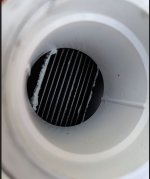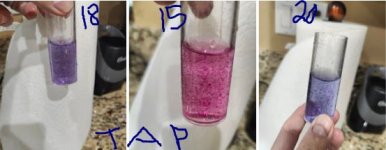ACID.
You may
I realized Leslie's Muriatic Acid is like 34% HCl and only costs like 10% more/gallon, whereas Home Depot's is less than half the HCl concentration.
I put maybe 1/3 gal in last night an pH got down to about 7.6. So, I'll plan to stick with adding Muriatic prn for now. Hopefully I've got pH handled.
"very best, most cost-effective"...that's exactly what I'm after. THANK YOU!
____________________________________
Calcium Hardness / Water Softener.
Since my Calcium Hardness seems to be at least somewhat of an issue, and considering a Water Softener system was suggested, I looked into it more.
We're down in San Diego, and I read a lot of the SW has hard water issues as we mostly get our water from the Colorado River. Last couple CH readings at Leslie's were 485 and 618.
When I do a full CSI calculation I'm getting about 0.10 (I listed my CSI variables/comments at the end).
However, Dirk's Central CA situation sounds similar and recommends aiming for CSI -0.3 is best with CH on the high end of the spectrum.
____________________________________
QUESTIONS:
Looking at the photos of my pool above, I have a type of "plaster" pool right? I think it's pebble tech but not really sure tbh. I'm prett sure it's not vinyl or fiberglass though LOL.
Leslie's puts a "!" for my CH (latest 618), but TFP pool basics for plaster with SWG says 250-650 ok
(What Are My Ideal Pool Levels?),
and y'all seem to be saying so long as it's under 650, CSI is the true north star, is that right? ... still CH that high might not be so great for the pumps/plumbing, right?
So, I might not even need a Water Softener for pool care, right?
If not, I was thinking about it anyway as we do get some of that crud on our faucets and stuff and it sounds like getting water hardness down would likely help long term longevity of our plumbing and the pool pumps and SWG anyway. I did just open up our SWG again and it looked pretty frosted after having just cleaned it maybe 3 months ago. Is my reasoning on track?
I shopped softeners a bit. Since (I think) our hardness is not hugely off-target, it seemed like these newer/cheaper "magnetic" / "induction" type water softeners might be a good option. They're simple to DIY install, much cheaper, apparently no maintenance, and should get the hardness down a good bit, but we wouldn't expect it to move the needle as much as a salt based softener system. But it seems like we don't need a major reduction in hardness anyway. Something like this:
Thoughts on this?
I did poke around for other softener threads, but there are 768 LOL.
 www.troublefreepool.com
This one from Lagoony helped a lot though...and he lives nearby!
www.troublefreepool.com
This one from Lagoony helped a lot though...and he lives nearby!
 www.troublefreepool.com
...I see a rec for a $400 Rheem softener, but then I'd need an installer. Don't think I could handle DIY'ing that.
www.troublefreepool.com
...I see a rec for a $400 Rheem softener, but then I'd need an installer. Don't think I could handle DIY'ing that.
_________________________________
CSI CALCULATION VARIABLES
pH 7.6
(pH keeps bumping up as noted but for now got it to 7.6 and I'm ready to keep bumping it down with muriatic and then letting it "bounce" with aeration which should get the TA down some if I undertand that right).
TA 94
(my Taylor kit agreed).
CH 618.
I tried to double check this on my Taylor but after 10 drops it still wasn't turning blue and seems to have some particulate pink stuff form. When I test Alkalinity I don't see any particulates, so I'm guessing I got some bad reagents here. I attached a photo. Do you think that means one or more of my CH reagents went bad? Dangit - it's a new kit!
CYA 40.
It was 48 at Leslie's but ~25-30 on my Taylor 9-way kit so we'll call it 40.
Looks like I ought to get this up some. I'll read up on it. If I get it to 70, CSI would be 0.04.
Temp 70
Salt 3400
___________
CSI 0.10
You may
I realized Leslie's Muriatic Acid is like 34% HCl and only costs like 10% more/gallon, whereas Home Depot's is less than half the HCl concentration.
I put maybe 1/3 gal in last night an pH got down to about 7.6. So, I'll plan to stick with adding Muriatic prn for now. Hopefully I've got pH handled.
"very best, most cost-effective"...that's exactly what I'm after. THANK YOU!
____________________________________
Calcium Hardness / Water Softener.
Since my Calcium Hardness seems to be at least somewhat of an issue, and considering a Water Softener system was suggested, I looked into it more.
We're down in San Diego, and I read a lot of the SW has hard water issues as we mostly get our water from the Colorado River. Last couple CH readings at Leslie's were 485 and 618.
When I do a full CSI calculation I'm getting about 0.10 (I listed my CSI variables/comments at the end).
However, Dirk's Central CA situation sounds similar and recommends aiming for CSI -0.3 is best with CH on the high end of the spectrum.
____________________________________
QUESTIONS:
Looking at the photos of my pool above, I have a type of "plaster" pool right? I think it's pebble tech but not really sure tbh. I'm prett sure it's not vinyl or fiberglass though LOL.
Leslie's puts a "!" for my CH (latest 618), but TFP pool basics for plaster with SWG says 250-650 ok
(What Are My Ideal Pool Levels?),
and y'all seem to be saying so long as it's under 650, CSI is the true north star, is that right? ... still CH that high might not be so great for the pumps/plumbing, right?
So, I might not even need a Water Softener for pool care, right?
If not, I was thinking about it anyway as we do get some of that crud on our faucets and stuff and it sounds like getting water hardness down would likely help long term longevity of our plumbing and the pool pumps and SWG anyway. I did just open up our SWG again and it looked pretty frosted after having just cleaned it maybe 3 months ago. Is my reasoning on track?
I shopped softeners a bit. Since (I think) our hardness is not hugely off-target, it seemed like these newer/cheaper "magnetic" / "induction" type water softeners might be a good option. They're simple to DIY install, much cheaper, apparently no maintenance, and should get the hardness down a good bit, but we wouldn't expect it to move the needle as much as a salt based softener system. But it seems like we don't need a major reduction in hardness anyway. Something like this:
Thoughts on this?
I did poke around for other softener threads, but there are 768 LOL.
Google search results
Using a water softener to lower calcium hardness
I have a 26,000 gallon plaster pool in San Diego, CA. It's about 2 years old and the calcium hardness has been slowly creeping higher due to evaporation. It's currently at 750 ppm, which is well above the recommendations here. My source water from the tap is about 250 ppm. I've asked around...
_________________________________
CSI CALCULATION VARIABLES
pH 7.6
(pH keeps bumping up as noted but for now got it to 7.6 and I'm ready to keep bumping it down with muriatic and then letting it "bounce" with aeration which should get the TA down some if I undertand that right).
TA 94
(my Taylor kit agreed).
CH 618.
I tried to double check this on my Taylor but after 10 drops it still wasn't turning blue and seems to have some particulate pink stuff form. When I test Alkalinity I don't see any particulates, so I'm guessing I got some bad reagents here. I attached a photo. Do you think that means one or more of my CH reagents went bad? Dangit - it's a new kit!
CYA 40.
It was 48 at Leslie's but ~25-30 on my Taylor 9-way kit so we'll call it 40.
Looks like I ought to get this up some. I'll read up on it. If I get it to 70, CSI would be 0.04.
Temp 70
Salt 3400
___________
CSI 0.10



















